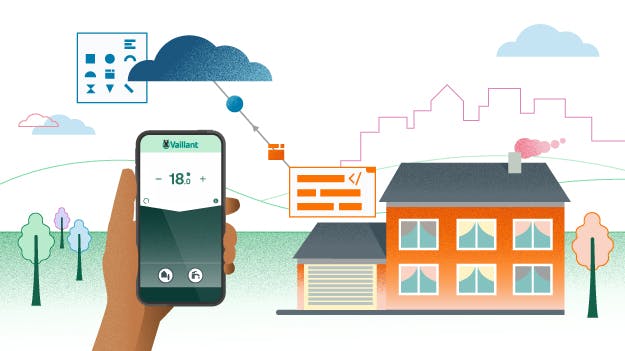Vaillant solves
scaling IoT challenges with MongoDB Atlas
INDUSTRY
PRODUCT
USE CASE
CUSTOMER SINCE
Vaillant solves scaling IoT challenges with MongoDB Atlas

Illustration by Ian T Craig
It was in 1874 that Johann Vaillant first founded his workshop. As a copper beater, he started building water pumps.
The very first was a "closed system" gas bathwater heater. It was slim, tall and wouldn’t look out of place on a steam train.
Heating has come a long way since then and Vaillant’s business has too. It now dominates the market internationally. 14,000 employees and 340,000 installation partners today support over 30 million customers in 60 countries across heating, ventilation and air conditioning (HVAC).
For Vaillant and many others that make, install, and maintain complex machines, the Internet of Things (IoT) has long promised a pathway to digital transformation. So much so, it’s introduced a designated API Developer Program to enable new customer services and opportunities.
Blending the physical and digital worlds with billions of sensors, manufacturers can monitor the operations of their products. It’s created new revenue streams and new opportunities for the Vaillant Group - everything from remote condition monitoring and artificial intelligence servicing to better product design.
As it turns out, generating IoT data is the easy part.
Managing, securing, and analyzing that data is another story. Therein lie the underlying challenges to successfully digitize the industry.

The very first "closed system" gas bathwater heater (source)
New data, new challenges
It was eight years ago that Vaillant first started connecting its devices to the internet. Its plan was to connect the HVAC industry and make the data available through APIs so any customer, partner or engineer could use it.
It didn’t take long for the company to have over 60,000 IoT-connected devices in the field. Just a year later, the number of devices almost doubled. All these were sending more data than Vaillant ever expected.
“We underestimated the adoption rate, the amount of data, and the timeframe,” says Norbert Koch, a software developer at Vaillant. “We had 70,000 devices generating 600,000 transactions per second. Every state change produced data that was sent and stored in our system. And it piled up quickly.”
Adding so much new data, so quickly, meant scaling Vaillant’s existing Azure CosmosDB database became difficult. The team had to constantly keep provisioning more resources to keep it running.
As data volumes grew, response times slowed and the system crashed regularly. With a limited query language, the team struggled to find and filter the relevant data. It put the promise of predictive maintenance and improved customer experience out of reach.
“Within just a few months, we noticed significant decreases in speed and performance and had to manually scale the database to meet specific requirements,” said Koch. “We quickly realized we needed a better database platform that could partner with us to improve scale and unlock the value of connected devices in the field.”
Jürgen Stauvermann, Senior Java Software Engineer, Vaillant

Blending the physical and digital world with Vaillant (source)
Connected partners
This new database had to be able to handle the unique demands of IoT time-series data and provide a single view of insights across all collected data.
“As we looked at various database solutions, we initially thought that we wanted to manage the ultimate solution,” said Juergen Stauvermann, Senior Java Software Engineer, Vaillant.
Most of the company’s data is hosted on Microsoft Azure so the team needed a solution that was immediately available on the platform. It also required superior scalability, flexibility and performance to be able to handle the streams of IoT data.
Vaillant was already using MongoDB in other projects and had experienced success. It was then that the team decided to migrate to MongoDB Atlas, the global cloud database service.
“We started the process by trying to build our own MongoDB cluster, but our teams are relatively small so we only had a limited amount of time for operational tasks. This influenced our decision to go with a fully-managed solution, available to us as a cloud service.”
Once the decision was made, the team was able to plan and redesign its existing schema. It meant that the data migration took all of 90 minutes.
Using MongoDB Atlas made the difference. “Today, we have over 1.9 billion records and there has been no downtime at all, and our customers immediately noticed the performance improvements,” said Koch. “The whole experience was fantastic.”
“We don’t have to manually scale the solution either,” said Stauvermann. “Everything runs much better on MongoDB Atlas. In the past, we had to manage write limits while scaling the database up or down to keep all systems running. More often than not, we would hit write limits in the evenings, making our systems go down overnight. But not anymore.”

Blending the physical and digital worlds
After the switchover, MongoDB Atlas on Microsoft Azure delivers four primary benefits:
- High-Speed Data Ingest and Real-Time Analytics
- Intelligent Edge
- Fast, Flexible Development Experience
- Keep Data Secure
Today, MongoDB’s flexible data model and scalable architecture creates a single view platform of all Vaillant’s disparate IoT data sources - more than 1.9 billion records. It can all be easily accessed, managed and audited by staff or regulators, wherever they are.
With MongoDB Atlas, powerful secondary indexing, and the aggregation framework, the team has decreased its database size by over 99% all the while increasing the throughput of its API by 250 percent. It means Vaillant can provide the kind of IoT services it envisioned all those years ago.
Following the migration, Vaillant launched serviceASSIST, an app that allows installers to remotely troubleshoot, and manage HVAC systems from any iOS or Android smartphone. It saves time, money, and promotes efficiency leading to higher customer satisfaction.
The team now plans to extend its mobile capabilities further with MongoDB Realm’s intuitive app development services. It will all help support a new mobile feature, Guided Repair, that will assist remote engineers with real-time data and solutions in the field.
Vaillant also has its sights on analytics using MongoDB Charts, a visualization tool for MongoDB data. It will help map Vaillant’s guidance maintenance, working with AI and machine learning to calculate climate and the weather to make devices even more efficient.
146 years on from its inception, Vaillant remains the market innovator. Now it's backed by the true promise of IoT with plenty more opportunities on the horizon.
Norbert Koch, Software Engineer, Vaillant